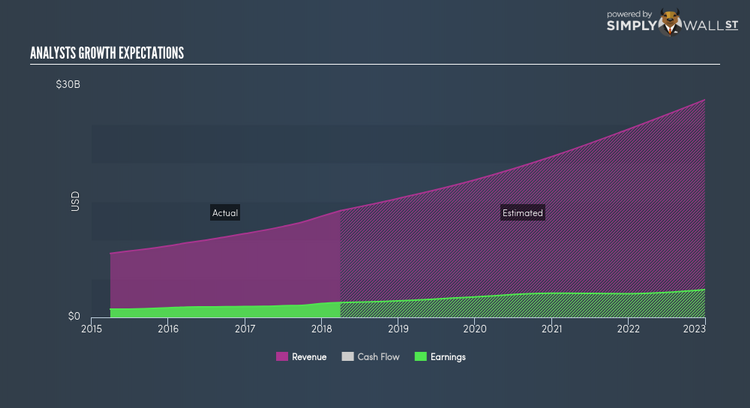Estimating The Intrinsic Value Of PayPal Holdings Inc (NASDAQ:PYPL)

In this article I am going to calculate the intrinsic value of PayPal Holdings Inc (NASDAQ:PYPL) using the discounted cash flows (DCF) model. If you want to learn more about this method, the basis for my calculations can be found in detail in the Simply Wall St analysis model. If you are reading this after June 2018 then I highly recommend you check out the latest calculation for PayPal Holdings here.
Crunching the numbers
I’ve used the 2-stage growth model, which simply means we take in account two stages of company’s growth. In the initial period the company may have a higher growth rate and the second stage is usually assumed to have perpetual stable growth rate. Firstly, I use the analyst consensus forecast of PYPL’s levered free cash flow (FCF) over the next five years and discounted these values at the cost of equity of 9.46%. This resulted in a present value of 5-year cash flow of US$20.04B. Want to understand how I arrived at this number? Check out our detailed analysis here.
The infographic above illustrates how PYPL’s top and bottom lines are expected to move going forward, which should give you some color on PYPL’s outlook. Now we need to calculate the terminal value, which accounts for all the future cash flows after the five years. It’s appropriate to use the 10-year government bond rate of 2.8% as the perpetual growth rate, which is rightly below GDP growth, but more towards the conservative side. After discounting the terminal value back five years, the present value becomes US$69.12B.
The total value is the sum of cash flows for the next five years and the discounted terminal value, which results in the Total Equity Value, which in this case is US$89.16B. In the final step we divide the equity value by the number of shares outstanding. This results in an intrinsic value of $75.09, which, compared to the current share price of $85.27, we find that PayPal Holdings is fair value, maybe slightly overvalued at the time of writing.
Next Steps:
Although the valuation of a company is important, it shouldn’t be the only metric you look at when researching a company.
For PYPL, there are three key aspects you should further examine:
Financial Health: Does PYPL have a healthy balance sheet? Take a look at our free balance sheet analysis with six simple checks on key factors like leverage and risk.
Future Earnings: How does PYPL’s growth rate compare to its peers and the wider market? Dig deeper into the analyst consensus number for the upcoming years by interacting with our free analyst growth expectation chart.
Other High Quality Alternatives: Are there other high quality stocks you could be holding instead of PYPL? Explore our interactive list of high quality stocks to get an idea of what else is out there you may be missing!
PS. Simply Wall St does a DCF calculation for every US stock every 6 hours, so if you want to find the intrinsic value of any other stock just search here.
To help readers see pass the short term volatility of the financial market, we aim to bring you a long-term focused research analysis purely driven by fundamental data. Note that our analysis does not factor in the latest price sensitive company announcements.
The author is an independent contributor and at the time of publication had no position in the stocks mentioned.

 Yahoo Finance
Yahoo Finance 
